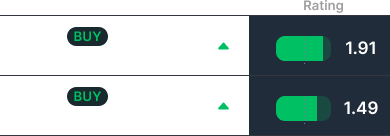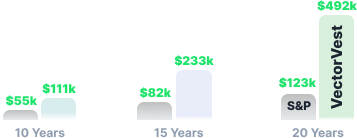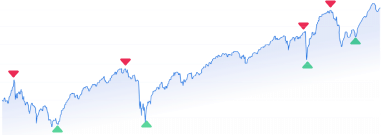Building a stock portfolio from scratch is a proactive step towards achieving your financial goals. Whether you’re eyeing long-term wealth growth, financial security, or the thrill of engaging with the market, stock portfolio building is a rewarding journey.
But where do you start building a portfolio on your own? We’ll show you how to build a stock portfolio with clear, actionable steps for the beginner investor. You’ll be well on your way to laying the foundation for financial success by the time you finish reading.
Most importantly, you’ll feel confident in building your own portfolio with specific stocks through our stock software. We tell you what to buy, when to buy it, and when to sell it – eliminating guesswork, emotion, and human error from your decision-making!
Why Build a Stock Portfolio?
From generating supplemental income in the here and now through swing trading or day trading to investing after retirement, there are so many reasons to consider building a stock portfolio. We’ll break it down below before guiding you through the process step-by-step.
Long-Term Wealth Growth and Financial Security
Investing in stocks offers the potential for significant long-term wealth growth.
Unlike savings accounts with minimal interest rates, the stock market provides opportunities for your investments to grow at a much higher rate, outpacing inflation.
This growth is key to building financial security over time, helping ensure that your savings don’t lose value in the long run.
Diversification of Investments to Mitigate Risks
One of the primary principles of investing is diversification, and a stock portfolio allows you to apply this strategy effectively. Diversification involves spreading your investments across various assets to reduce risk.
By owning stocks in different companies and sectors, you can mitigate the impact of any single stock’s poor performance, which is crucial in safeguarding your investments against market volatility.
The Power of Compound Returns
The concept of compound returns is another compelling reason to build a stock portfolio. Compound returns mean that you earn returns not only on your initial investment but also on the gains that your investment has already made.
Over time, this compounding effect can significantly increase the value of your portfolio, especially if you reinvest dividends and earnings. This is how modest investments can grow substantially over decades.
It’s also important to start now. The more time you have on your side, the more you’re able to take advantage of compounding interest.
But what is the advantage of investing early for retirement, exactly? Simply put, you can retire earlier all while spending less money on your retirement fund. Compounding interest can lead to some astounding returns. So, let’s talk about how to build a stock portfolio below!
How to Start Building a Stock Portfolio From Scratch on Your Own
Building a stock portfolio from scratch is an exciting venture that requires a strategic approach. From setting your goals to crafting your strategy, picking assets, monitoring your portfolio, and more – there’s a lot that goes into it.
However, we’ll simplify it below so you can see just how attainable your financial goals are. The process of stock portfolio building becomes dramatically easier with the help of our stock advisory, too. Here’s how to build a stock portfolio for beginners…
Setting Clear Investment Goals and Objectives
The first step in building your portfolio is to establish clear investment goals and objectives. Are you investing for income in retirement, buying a house, or funding education?
Your investment horizon – the time frame you have to invest – and your risk tolerance play crucial roles in shaping these goals.
Short-term objectives might lean towards more liquid assets, while long-term goals allow you to weather market volatility and aim for higher returns. Be specific about what you want to achieve and by when, as this will guide your investment decisions.
Fundamentals of Stock Market Investing
Before diving into stock selection, it’s vital to grasp the fundamentals of stock market investing. Understand how the stock market works, the difference between stocks and other investment vehicles, and what affects stock price, such as economic indicators, company performance, and market sentiment.
Familiarize yourself with basic terms like dividends, market capitalization, and P/E ratios. Knowledge of these concepts will enable you to make informed decisions and analyze stocks effectively.
We have a ton of beginner resources in our blog on topics like how to analyze a stock, what happens to stocks in a recession, types of investments for retirement, technical analysis vs fundamental analysis, and more.
Crafting Your Investment Strategy
Developing a personalized investment strategy is the next crucial step. First, decide whether you want to be an active or passive investor.
Active investing involves regularly buying and selling stocks to capitalize on market movements, while passive investing is about building a portfolio and holding onto stocks for the long term.
Your strategy should align with your risk tolerance. Are you comfortable with high-risk investments that offer the potential for higher returns, or do you prefer a more conservative approach? This decision will influence the types of stocks you select.
Consider incorporating different investment styles, such as growth investing, which focuses on companies expected to grow at an above-average rate compared to their industry, or value investing, which involves picking stocks that appear to be trading for less than their intrinsic or book value. You can compare and contrast growth vs value investing in our blog.
You can also look into other retirement investment strategies like time in the market vs timing the market or dollar cost averaging vs timing the market, as we’ve reviewed both these approaches to help you determine which aligns with your specific goals and preferences.
From retiring on dividends to making money swing trading, the possibilities are endless. That being said, let’s talk about how to pick a stock regardless of your strategy – as this is perhaps the most important aspect of how to build a stock portfolio.
Selecting the Right Stocks and Assets
Choosing the right stocks is a cornerstone of stock portfolio building. Start by exploring different industries and markets. Look for sectors showing growth potential or resilience in the current economic climate.
Consider trends, such as technological advancements or shifts in consumer behavior, which could impact certain industries positively or negatively. Right now, for example, companies involved in the AI boom are thriving.
Utilize stock screening tools to narrow down your choices. These tools allow you to filter stocks based on specific criteria like market cap, dividend yield, P/E ratio, or industry sector. This helps you find companies that match your investment criteria. We have a guide on how to scan for stocks if you’d like to learn more.
You can also stay updated with investment news and resources. Financial news websites, investment blogs, and financial analyst reports can provide insights into promising companies and sectors.
Once you have a list of potential companies, conduct a thorough evaluation. Investigate each company’s financial health by examining balance sheets, income statements, and cash flow statements. Assess their stability, profitability, and growth potential. Look into their business model, management team, competitive position in the market, and any risks they might face.
If you’re looking for the best ways to invest money for retirement through a more passive approach, you’d want to find the best retirement fund or the best index fund for retirement.
On the other hand, maybe you want to take a more active approach and earn more income. If that’s the case, you’ll want to learn how to select stocks for swing trading or how to pick stocks to trade options.
Whatever the case, you’ll find that manually looking for stocks and combining fundamental analysis with technical analysis is time-consuming and complex.
Wouldn’t it be nice if there was a better way to build your stock portfolio? You may be starting to wonder…are financial advisors worth it? The answer is no.
In fact, we’ll show you why you don’t need a financial advisor in just a few moments. With the best stock analysis app, you can effortlessly start building a stock portfolio on your own! In the meantime, let’s highlight the need for asset allocation and diversification.
Allocating Assets and Diversifying Your Portfolio
Safe stock portfolio building means including a variety of asset classes. While equities might be a primary component, incorporating bonds, ETFs, mutual funds, and alternative investments like real estate or commodities can mitigate risk.
Diversification across asset classes helps in balancing the portfolio against market fluctuations, as different asset classes often react differently to the same economic events.
Tailoring your portfolio’s composition to your individual risk tolerance and investment time horizon is crucial. For those with a longer time horizon, a more aggressive allocation might be suitable, leaning more heavily toward stocks.
Conversely, if you’re working on your asset allocation in retirement specifically, you’ll probably lean towards fewer growth stocks and more steady dividend-paying companies.
Monitoring and Adjusting Your Portfolio
So you know how to build a stock portfolio – now what? This isn’t something you set and forget. Rather, you’re constantly building a stock portfolio, monitoring and adjusting as things change over time.
Conduct regular reviews of your portfolio’s performance. Analyze how each investment is contributing to your overall financial goals. This includes not just looking at returns but also considering how each asset fits into your overall strategy.
Such reviews can highlight areas where changes might be needed, whether to capitalize on market gains or to cut losses on underperforming stocks.
Most beginner investors find that monitoring their stock portfolio is the hardest part of things – they don’t know when to buy stocks or when to sell a stock for profit. You can rely on trading tools like VectorVest to help you manage your portfolio with confidence.
That being said, it’s time we officially introduced you to the best trading platform if you’re ready to start building a stock portfolio on your own.
Stock Portfolio Building is Easy With VectorVest’s Guidance and Insights!
Getting started with stock portfolio building can often feel overwhelming for beginners. VectorVest is here to leave you feeling confident in picking stocks and managing your portfolio with our proprietary stock rating software.
We track and rank 16,000 stocks daily using an intuitive VST system that simplifies the process of stock analysis to save you time and stress while empowering you to earn higher returns. You can rely on just 3 ratings for clear, actionable insights:
- Relative Value (RV): Compares a stock’s long-term price appreciation potential (forecasted three years out), AAA corporate bond rates, and risk. It offers much better insight than a simple comparison of price to value alone.
- Relative Safety (RS): This risk indicator is calculated through a detailed analysis of a company’s financial consistency & predictability, debt-to-equity ratio, business longevity, sales volume, price volatility, and other factors.
- Relative Timing (RT): Helps you determine when to buy, when to sell, and when to wait. This rating is based on the direction, dynamics, and magnitude of a stock’s price movement. It’s computed day over day, week over week, quarter over quarter, and year over year.
Each rating sits on its own scale of 0.00-2.00 with 1.00 being the average, making interpretation quick and easy. Just pick safe, undervalued stocks rising in price as you start building your own stock portfolio! Better yet, follow the clear buy, sell, or hold recommendation the system issues for any given stock, at any given time.
Whether you’re looking for the best swing trading stocks or the best beginner stocks, VectorVest can help you find them in just a few clicks. You can pull up our stock picks and sort by whatever aligns with your goals – whether it’s safe stocks, growth stocks, or some specific industry or sector.
It’s the best swing trade alert service, but you can use it no matter how you build a stock portfolio. You can get started risk-free today for just $0.99. Try it out with a free stock analysis and start building a stock portfolio on your own confidently today!
Final Thoughts on How to Build a Stock Portfolio for Beginners
Stock portfolio building may seem daunting, but it’s a journey filled with opportunities for growth and learning. Now that you know how to build a stock portfolio, it’s time to get to work!
Start by setting clear investment goals, understanding the fundamentals of the stock market, and developing a strategy that aligns with your risk tolerance. Selecting the right stocks, diversifying your portfolio, and continuously monitoring and adjusting your investments are key steps to success.
You can learn more about the world of investment in our blog. We have resources like should I buy stocks when they are low or high, how to do fundamental analysis, how to do technical analysis, investing in a down market, the best stock market technical indicators, the best time of day to buy stocks, how to buy the dip, and more.
As we wrap up our guide on how to build a stock portfolio for beginners, we want to once again remind you that building a stock portfolio doesn’t have to be stressful or uncertain. Enjoy complete clarity on the path ahead by investing in a VectorVest subscription!!
What you should do next…
- Get our latest blogs delivered right to your inbox, subscribe to our newsletter.
- The market moves fast! Get our most current evaluation of this stock with our FREE stock analysis tool.
- Looking for stock picks? Not sure if now is the right time to buy/sell? For a limited time, enjoy the full benefits of a 30-day subscription to VectorVest for only [offer_txt] (usually up to [saving_txt]/month) . Get access to our full list of screeners showcasing our top stock picks that tell you exactly what to buy, when to buy, and when to sell.












